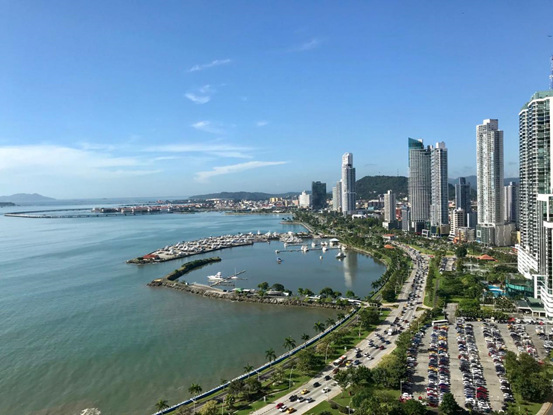


A Chinese vessel passes by the Miraflores Locks of the Panama Canal. Photo by Zhu Dongjun from People’s Daily
The Panama Canal, connecting the Pacific Ocean and the Atlantic Ocean, is a “golden waterway” for world shipping.
Striving for interconnection, Panama is currently promoting the National Logistics Strategy of Panama 2030, with an aim to build itself into a global logistics hub.
This strategy echoes Chinese President Xi Jinping’s proposal of the Belt and Road Initiative, as a result of which the two countries are a pair of natural partners for the joint construction of the Belt and Road.
The expansion project of the Canal was completed two years ago, which has allowed ships of larger size to transit and further enlarged the handling capacity of the waterway. The centenary canal has since taken a new lease of life.
At the inauguration ceremony of the project, Chinese container vessel COSCO Shipping Panama became the first vessel to transit the expanded Panama Canal. It revealed the importance that Panama attached to China’s marine logistics.
At present, China is the Canal’s second largest user, as well as the second largest source of imports of goods and the second largest destination of exports of goods.
Statistics from the Panama Canal Authority (PCA) indicated that over 22 million tons of goods transported through the Canal were from China, and nearly 20 million tons were to China in the 2018 fiscal year.

A long shot of the Panama City. Photo by Zhu Dongjun from People’s Daily
PCA former officer Rodolfo Sabonge told People’s Daily that the number of Chinese vessels passing through the Panama Canal had been surging from China’s accession to the WTO. “China’s economic and trade growth is good news to the world,” he added.
Apart from the direct contribution to the Canal’s revenue, Chinese enterprises also participated in the expansion and upgrade projects of the ports along the waterway, promoting comprehensive improvement of the Canal’s operation capability.
Colon Free Trade Zone (FTZ) located on the Pacific bank of the Canal is the largest FTZ in the Western Hemisphere, and also the second largest in the world. China is the largest supplier of goods of the FTZ.
The Margarita Island port, invested by China’s Lanbridge Group, belongs to the FTZ. Currently the port is under construction, and will become one of the core ports of the world upon completion.
The Panama Canal is one of the world’s most important waterways where about 6 percent of the global trade passes annually. Therefore, the navigation of the Canal is always seen as a “barometer” of global trade.
Eric Dormoi, foreign trade advisor of the Panamanian trade company Exporta Consulting, told People’s Daily that his country did not want to see the rising trend of trade protectionism, explaining that the more commodities passed through the Panama Canal, the more profits his country could gain.
“Protectionism not only impacts Panama, but also the trade and economy of Central America. President Xi’s proposal to build an open world economy aims to protect global interests, and that’s why he has received support from most of the countries in the world,” Dormoi said.
Rosmer Jorado, president of Panamanian Association of Exporters believes that the Belt and Road construction had promoted Panama’s light manufacturing and assembling industries, saying it is also conducive to the country’s infrastructure construction.
“Panama is the first country in Latin America and the Caribbean to sign the memorandum of understanding on the Belt and Road cooperation with China, and the Belt and Road initiative will help Panama attract investment and secure the country’s position as the gate of the America,” he noted.
An open world economy was the lifeline of the Panama Canal, said Manuel Grimaldo, general manager of the Colon Free Trade Zone.
“The alignment of China’s Belt and Road Initiative and the National Logistics Strategy of Panama 2030 conforms to the trend of history,” Grimaldo noted, adding that China-Panama cooperation will benefit the whole world.
The general manager expressed his confidence in the prospect of China-Panama trade and believed that President Xi’s visit would further promote the progress of the two countries’ cooperation in economy and trade.
 Fire brigade in Shanghai holds group wedding
Fire brigade in Shanghai holds group wedding Tourists enjoy ice sculptures in Datan Town, north China
Tourists enjoy ice sculptures in Datan Town, north China Sunset scenery of Dayan Pagoda in Xi'an
Sunset scenery of Dayan Pagoda in Xi'an Tourists have fun at scenic spot in Nanlong Town, NW China
Tourists have fun at scenic spot in Nanlong Town, NW China Harbin attracts tourists by making best use of ice in winter
Harbin attracts tourists by making best use of ice in winter In pics: FIS Alpine Ski Women's World Cup Slalom
In pics: FIS Alpine Ski Women's World Cup Slalom Black-necked cranes rest at reservoir in Lhunzhub County, Lhasa
Black-necked cranes rest at reservoir in Lhunzhub County, Lhasa China's FAST telescope will be available to foreign scientists in April
China's FAST telescope will be available to foreign scientists in April "She power" plays indispensable role in poverty alleviation
"She power" plays indispensable role in poverty alleviation Top 10 world news events of People's Daily in 2020
Top 10 world news events of People's Daily in 2020 Top 10 China news events of People's Daily in 2020
Top 10 China news events of People's Daily in 2020 Top 10 media buzzwords of 2020
Top 10 media buzzwords of 2020 Year-ender:10 major tourism stories of 2020
Year-ender:10 major tourism stories of 2020 No interference in Venezuelan issues
No interference in Venezuelan issues
 Biz prepares for trade spat
Biz prepares for trade spat
 Broadcasting Continent
Broadcasting Continent Australia wins Chinese CEOs as US loses
Australia wins Chinese CEOs as US loses